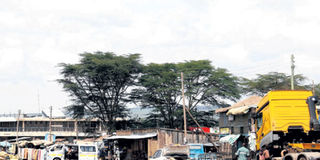As Nakuru expands, developers jostle for space in the suburbs

A section of the rapidly growing Salgaa area, on the Nakuru-Eldoret road. PHOTO| FILE| NATION MEDIA GROUP
What you need to know:
Mureithi said the area is offering developers a better alternative due its availability of land, fairly negotiable prices, accessibility from Nakuru town, and potential for fast economic growth.
In Naka, an area five kilometres from Nakuru CBD that is attracting earners above the middle class, a 50X100-metre piece of land is currently going for an average of Sh3.5million, according to property dealers.
A similar piece of land is selling for Sh1 million in Salgaa, even though this a quadruple increase from 2005, when the same size of piece of land could easily go for Sh250,000, says Gilbert Kabage, the managing director of Pata Commercial Enterprises.
Finding land for development within a 10-kilometre radius from the Nakuru CBD is either a near impossibility — or perhaps beyond the reach — for the middle class, a population aggressively spreading its influence into the fourth largest town in Kenya.
This is pushing property investors farther away from the town, thereby not only disintegrating land ownership and management in the remote areas, but also the prices. And Salgaa, a small town 30 kilometres from Nakuru on the road to Eldoret, is one of the areas benefitting from this insatiable demand for land.
“People used to own land in large scale from Kabarak up to Salgaa, but this has changed as land buying companies have started buying up all these large tracts and sub-dividing them to meet the needs of buyers,” Simon Mureithi,
a manager at the Nakuru-based Muigai Commercials, said during an interview with DN2.
Mureithi said the area is offering developers a better alternative due its availability of land, fairly negotiable prices, accessibility from Nakuru town, and potential for fast economic growth.
In Naka, an area five kilometres from Nakuru CBD that is attracting earners above the middle class, a 50X100-metre piece of land is currently going for an average of Sh3.5million, according to property dealers. A similar piece of land is selling for Sh1
million in Salgaa, even though this a quadruple increase from 2005, when the same size of piece of land could easily go for Sh250,000, says Gilbert Kabage, the managing director of Pata Commercial Enterprises.
“Land is no longer available in Nakuru town and investors are moving to the suburbs, and Salgaa is one of the places property developers are moving into to build rental houses,” said Kabage.
He defined Salgaa as the equivalent of Nairobi’s Westlands since it manifests characteristics of attracting international developers who have changed the structural and physical design of the once sleepy area.
Salgaa had a population of 4,740 in 2009, according to the Kenya National Bureau of Statistics, but the numbers have steadily increased, considering the notable developments recorded in the area.
One- to two-storey buildings have sprung up in the town, providing commercial and office space to business people at an average of Sh40 per square foot, compared to Sh65 in the CBD.
Salgaa sits on a regional trans-route for long haul cargo vehicles transporting goods to Congo, Uganda, Rwanda and South Sudan. Drivers make a stop here for a night or bite. It has also attracted a number of learning institutions, wholesale outlets, restaurants, clubs and bars.
However, its drainage, lighting and roads need attention. In October this year, the Nakuru County Assembly approved new guidelines for developers, including a requirement for developing access roads and drainage systems within their investments.
This, the assembly noted, would control the haphazard nature of real estate developments in various parts of the county, ignoring the crucial social amenities such as playing grounds, access roads and drainage systems.
Rachel Maina, the Lands, Housing and Physical Planning executive, says plans are underway to establish a County Land Management Bill intended to streamline property and real estate investments in the county.
“The Bill will devolve all issues related to management of land and property development,” she said. “It will localise the national Physical Planning Act to conform to the county’s land needs and developments the real estate sector.”
Although scanty information is available on the relative cost of property in Nakuru compared to Nairobi, Kisumu and Mombasa, it is generally believed that the county offers steady
competition to Nairobi due to its growing middle class population and unique attraction to local and international investors.





